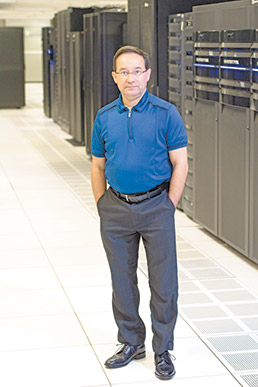Subscriber Benefit
As a subscriber you can listen to articles at work, in the car, or while you work out. Subscribe Now (IBJ Photo/ Eric Learned)
(IBJ Photo/ Eric Learned)Paul Baltzell is state government’s chief information officer, aposition that provides technical services to some 100 agencies and oversees 340 employees, including server administrators, help-desk staff, programmers and more.
But the job is about more than maintaining the state’s hardware and software. It’s also about innovating how state government uses technology.
To that end, the state has launched a management performance hub, where analysts use data to try to solve pressing problems.
Among its first projects are an effort to reduce infant mortality and an analysis of what programs keep prisoners from committing new crimes post-release. Baltzell, 45, weighed in on several aspects of his job.
On the infant-mortality project:
We brought data from more agencies than any other state had ever brought together. We went across eight, nine, 10 different agencies and brought large quantities of data together to try and solve a problem.
So I’m excited about the results because we can actually make sure we’re budgeting the funds in the right place.
[Researchers] found that one of the key factors was prenatal visits. Most people have a smartphone, regardless of their income level. We’re working on a mobile app to connect those mothers to services so they get to those prenatal visits—whether it be transportation, child care while they go to a visit, or needing a doctor who’s available after hours.
On the prisoner project:
Right now, we’re looking at recidivism and which programs work with which offenders so we can target those programs to the offender that they’re most effective with. And that’s actually going to be due out [within days].
On how the Indiana Office of Information Technology operates:
We are basically funded by bill-back. We have received a few appropriations, but those are usually for modernization to help the agencies.
I have an oversight role. So, the CIOs in each agency have a line to their boss, but they have a dotted line to me. If there’s an IT contract or something, we have an oversight role to try and ensure that they’re doing the right thing. Also, if one agency’s trying to do something and we know someone else is [doing something] that’s very similar, part of our mission is to try to bring that together so we can spend money more wisely.
There are a few other states that are what we are, which is a consolidated model, but the majority of states are not consolidated; each entity has [its] own infrastructure. Few states have a single data center where everything is hosted out of.
Consolidation is the trend, and we’re one of the leaders in that. And that was done back in the 2006 time frame.
On the biggest tech trend affecting his job:
I think it’s data analytics. Every time you get on Amazon, right, they know what you’re thinking about buying. We need to be more responsive to constituents and give them what they want without their having to look for it.
Most people go to Google and type what they want. So, we need to be that easy. Data analytics can help us with that, as well as help us target our spending on the right things. I think it’s going to be disruptive in government, not just ours but [in] other states and the federal government.
On his vision for the way technology could transform state workers:
Right now, our agencies kind of work in a silo. [In the future], if I’m a case worker in the field and I’m working with a child on an instance of abuse reported, I can go into the home and pull up on my iPad or Surface and say, “OK, Dad is on parole,” and his parole officer is automatically notified that I paid a visit. He’s not going to show up at the same time, but he might say, “Hey, this happened. What’s going on?” So they just engaged the Department of Corrections.
OK, now potentially, given the information we have on yearly earnings, [the family] might be eligible for [Women, Infants, and Children federal nutrition program] benefits because they have a baby. So the case worker has them fill an application out for that and notifies a counselor in the Health Department. And, since Dad is out on parole but hasn’t found a job yet, the case worker notifies someone at the Department of Workforce Development because they have a career-training plan that might fit him.
I think that’s where it’s going and it’s my belief that that’s where we need to take it.
Click here for other interviews.
Please enable JavaScript to view this content.
